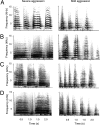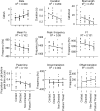Chimpanzees modify recruitment screams as a function of audience composition
- PMID: 17942683
- PMCID: PMC2040427
- DOI: 10.1073/pnas.0706741104
Chimpanzees modify recruitment screams as a function of audience composition
Abstract
Wild chimpanzees produce acoustically distinct scream vocalizations depending on their social role during agonistic interactions with other group members. Here, we show that victims during such agonistic interactions alter the acoustic structure of their screams depending on the severity of aggression experienced, providing nearby listeners with important cues about the nature of the attack. However, we also found that victims of severe attacks produced screams that significantly exaggerated the true level of aggression experienced, but they did so only if there was at least one listener in the audience who matched or surpassed the aggressor in rank. Our results are consistent with the more general hypothesis that chimpanzees possess sophisticated understanding of third-party relationships, so-called triadic awareness, and that this knowledge influences their vocal production.
Conflict of interest statement
The authors declare no conflict of interest.
Figures



References
-
- de Waal FBM, van Roosmalen A. Behav Ecol Sociobiol. 1979;5:55–56.
-
- de Waal FBM. Science. 2000;289:586–590. - PubMed
-
- Cheney DL, Seyfarth RM. Behaviour. 1989;110:258–275.
-
- Judge PG, Mullen SH. Anim Behav. 2005;69:1345–1355.
Publication types
MeSH terms
LinkOut - more resources
Full Text Sources

